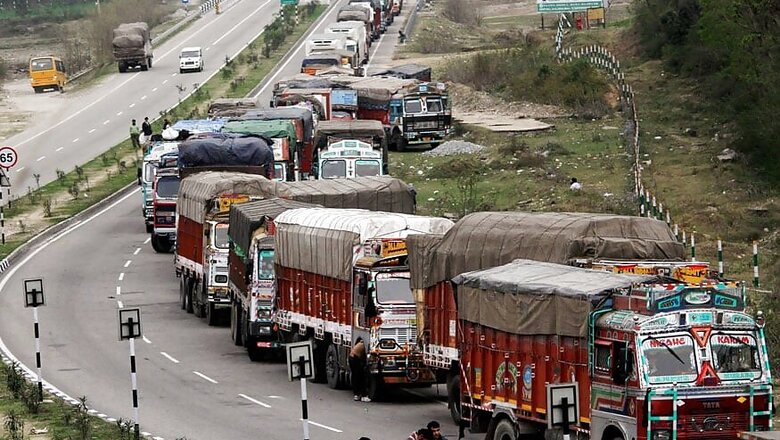
views
China is like that annoying cousin you have who seems to do better than you in everything and remains the point of comparison for your parents. India’s GDP, per capita income, rate of urbanisation, growth in manufacturing, and almost everything else is compared with that of China’s. It’s the same with roads and infrastructure.
Consider these statistics: In 2016, China had around 3,54,800 kilometres in national highways as against around 91,000 kilometres in India. When it comes to high-speed expressways with multiple lanes, controlled access, and no stoppages, the gulf is even wider. China has around 1,31,000 kilometres of expressways as against a paltry 1,324 kilometres in India.
Another favourite statistic to highlight the difference in the quality of roads is the time it takes to travel between two of the biggest cities in the respective countries. By road, it takes about 12.5 hours to travel between Beijing and Shanghai, which is a distance of 1,200 kilometres. In India, the 1,400 kilometres between Delhi and Mumbai takes about 23 hours by road.
The importance of the road network can never be understated in the development process of any country. Good quality infrastructure boosts trade and helps in developing towns and cities in the hinterland. It also provides massive employment opportunities, both directly in the construction of roads and indirectly increasing economic activity through improved connectivity.
Realising the importance of road networks, the present government has consistently increased its expenditure on building roads since 2014.
In this year’s Budget, the finance minister proclaimed that the government has made an all time high allocation to roads and Railways. It has set itself a target of completing 9,000 kilometres of national highways in 2017-18. The total allocation for the building of highways and normal roads in this year’s Budget is Rs. 59,500 crores, a hike of Rs. 8,200 crores. Apart from the budgetary outlay, the Finance Minister also mentioned the use of Special Purpose Vehicles and “innovative monetizing structures like Toll, Operate and Transfer (TOT) and Infrastructure Investment Funds (InvITs)” by the National Highway Authority of India (NHAI) to achieve the target.
The good sign in few of the recent budgets is that the capital expenditure on expanding the road network has been steadily increasing, whereas, revenue expenditure has gone down.
For the uninitiated, revenue expenditure is the expenses on salaries and wages, and any other item that is recurring in nature and deals with day-to-day operations. Capital expenditure, the preferred kind in any budget, has to do with the creation of capital assets, which has the potential to generate revenue, either directly or indirectly, in the future.
The government had a capital expenditure outlay of Rs 27,000 crores, Rs 41,000 crores and Rs 54,000 crores in 2015, 2016, and 2017, respectively. However, a point to note is that the actual utilisation by the ministry of road has been significantly lesser than the budgetary estimates. In 2016-17, for example, the actual expenditure was 10% lower than the budgetary estimate.
A COMPREHENSIVE OUTLOOK TOWARDS TRANSPORT
While the budgetary allocation in the past few years, including this year's, has been encouraging, the government needs to take a more comprehensive outlook towards improving the state of road transport in India. Budgetary allocation is just the first step towards achieving a seamless network of good roads in India.
Here are some issues that need to be addressed to achieve this:
1. Delays in projects: One major issue facing the construction of new roads and highways is the enormous delays in getting environmental, forest, and wildlife clearances for the projects. These delays add to the overall cost of the project and delays the intended benefits. It approximately takes 12-15 months to get an environmental clearance; 1-2 years to get a forest clearance; and more than 3 years to get a wildlife clearance.
Needless to say, delays in land acquisition also add significantly to the timeline and cost of the project. A simple solution can be to set up a coordination mechanism between the Ministries of Finance, Environment and Forest, and Defence. This should also involve representatives from the state government to further ease the acquisition of land and receipt of clearances.
2. Slow pace of road construction: There is a big discrepancy between the target for road construction and actual construction. For the year 2014-15, the target was 6,300 kilometres and completion rate was 69% (or 4,340 kilometres). It implied an average road construction rate of 12kms/day, this has drastically improved to around 22 kms/day in 2016-17. However, it is significantly lesser than the target of 41 kms/day.
3. Private financing of road projects: There are various models of PPP used for road projects in India, however, none of them have worked too well in the recent past. The sector is mostly struggling to find private financing for the projects. The private players are facing financial capacity constraints and there are also limited debt products for such long-term projects. Another significant constraint is the high-inherent risk in these projects. These infrastructure projects become financially viable only over a period 20-30 years, during which there can be changes in the political and economic landscape, which can lead to a loss of bargaining power for the private player. This generally dissuades them from entering the sector.
4. Road safety: The government needs to drastically rethink the road safety measures in place and reduce the number of fatalities on Indian roads. Between 2005 and 2015, the number of road accidents increased by 14%, and road accident fatalities increased by 54%. In 2015, there were about five lakh road accidents in India, which killed about 1.5 lakh people and injured about five lakh people.
Last year, the ministry allocated Rs. 250 crores towards road safety, which amounts to 0.4% of its total budget. In comparison, the US spends about 20% of its road budget on safety measures.
5. Road maintenance: The amount spent on maintenance of roads in India is a small fraction of what is spent on the construction of new roads. The result is seen in potholes, weaker bridges, poor pavements, etc. These, in turn, lead to more accidents and fatalities. Maintenance in India is carried out only when the issue is highlighted and it desperately requires attention, instead of on a preventive basis. Last year, the ministry allocated just 5% of its budget towards maintenance.
6. Stoppages and tolls: Finally, good quality roads have to be complemented by a reduction in stoppages on the highway. India has one of the highest stoppage times in tolls. It is estimated that the truckers industry bears a loss of Rs 1,45,905 crore annually on account of frequent stoppages made at toll barriers resulting in loss of man hours and fuel. The plan to install RFID tags based toll collection across all highways of India should be pursued diligently.
Further, Indian trucks spend an enormous amount of time at the various check posts while traversing into different states. While GST has removed many tax-related check posts, there are still various other check posts by other departments like the forest and environment department, police, RTO, etc. A World Economic Forum Report observes “a truck carrying goods from Gurgaon to Mumbai has to pass through 36 checkpoints and took up to 10 days to reach its destination.”
The average wait time of Indian trucks at check posts being 70 minutes, compared with the global average of 5 minutes. This result in an extremely low average distance covered per day for Indian truckers, which is 300 kilometres per day as compared to a global average of 700-800 kms/day.
This government’s commitment towards improving the road network in India can be clearly observed by the increased budgetary allocation year after year since 2014. However, to truly make a difference in road usage experience for private and commercial users, the Ministry of Road Transport and Highways needs to look beyond just building of roads.
— Author is a research fellow at the Takshashila Institution, an independent and non-partisan think-tank and school of public policy.



















Comments
0 comment